
16 January 2001
 Christopher
B. Wright is no longer the
Editor in Chief of OS/2 eZine, but he'll still be around now and then to see
what's going on. During his "retirement" he plans to work more on
his web comic strip, Help Desk.
Christopher
B. Wright is no longer the
Editor in Chief of OS/2 eZine, but he'll still be around now and then to see
what's going on. During his "retirement" he plans to work more on
his web comic strip, Help Desk.If you have a comment about the content
of this article, please feel free to vent in the OS/2
eZine discussion forums.
|
Previous
Article |
|
Next Article |
MIDI Station Sequencer 2.2
In one of my many other secret lives, I am
a musician who records his music on his computer and distributes it over the internet
in the mp3 format (on sites like MP3.com, MusicBuilder.com, etc.)
For quite some time, home studio recording
meant that you either bought some very, very expensive hardware, or you had an Atari,
a Mac, or a Windows machine. Having no really epensive equipment, Atari, or Mac,
I have a Windows partition on my workstation that I use as my primary mutlimedia
recording studio.
Lately, however, this has been turning around.
Christopher Hodges has created a truly interesting program called MIDI Station Sequencer,
which is -- you guessed it -- a MIDI sequencing program for OS/2. With the release
of version 2, however, it became more than that -- it can also record audio tracks.
Suddenly, OS/2 has the ability to record both MIDI and audio tracks. Could it be
that I could start recording my music on my favorite operating system?
Even more recently, alpha versions
of the next release of MIDI Station Sequencer have appeared on Hobbes -- and they
promise to offer even more functionality than 2.2. 2.2 is the latest official release,
however, and the next series of articles will deal with using it as a computer-based
recording studio.
Part One: Installation
The most difficult part of using
MIDI Station Sequencer is installing it. Not because the install program itself
is difficult to use, it's actually quite straightforward. Unfortunately, MIDI Station
Sequencer depends on your sound card being able to use the RTMIDI drivers for OS/2
in order to properly record MIDI tracks. What is RTMIDI? Simply put, it's a high
resolution driver that allows OS/2 to play and record MIDI tracks with a very high
degree of precision -- more precision, in fact, than is available on other platforms
(like Windows). Unfortunately, getting a sound card to actually use RTMIDI is something
of a herculean effort. If you happen to have a Crystal TidalWave 128 ISA card, you're
in luck, because RTMIDI works perfectly on it. If you happen to have the MMPack
from Thetaband Software , you might also
be in luck, because the MMPack includes an installer that greatly increases the
chance of RTMIDI working with your sound card, whatever it might be. If you have
a Creative Labs sound card, your luck will be greatly reduced -- Creative abandoned
the OS/2 market a long time ago, and while there is a project on OS/2 Netlabs underway
to port the Linux drivers for the latest Creative soundcard over to OS/2, it is
still an alpha release and does not support RTMIDI.
If you have a PCI sound card, chances
are not good that you will be able to use MIDI Station Sequencer for MIDI sequencing.
The only PCI sound cards that I know of with any kind of OS/2 support are ones using
the Crystal chipset -- and even then, success has been inconsistent. In my own case,
I was able to get a Crystal-based PCI card to play sound, but I could never get
it to use the MIDI port at all. Some people have have more success, some less.
This is by far the biggest hurdle
to using this application, and unfortunately it's not really something the developer
can do anything about. If you can get your sound card to recognize RTMIDI, you're
over the biggest hurdle, and can start playing with the application.
Part Two: Exploring MIDI Station
Sequencer
MIDI Station Sequencer has evolved
a great deal from its relatively humble origins. Not only can it record MIDI in
"real time," it's also added support for digital audio recording and a
few of the fancier MIDI editing methods. In fact, MIDI Station Sequencer has most
of the features you'd expect to find in full-fledged Home Studio recording software
for other platforms.
The Main Screen
The Main Screen is the "command
center" of the application. From here you can access all of the other parts
of MIDI Station Sequencer, as well as view how many MIDI tracks you're working with
at the moment.
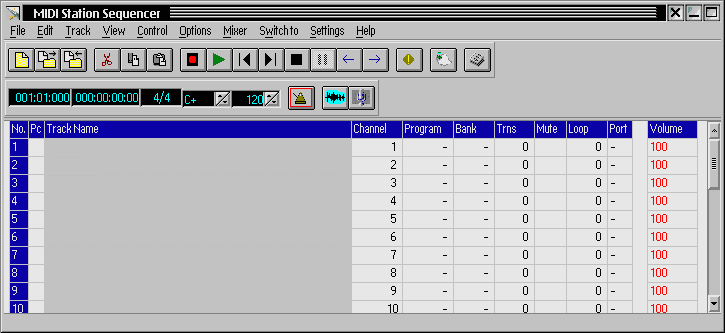
[Click here for a full sized version of this graphic]
The Mixer
The
Mixer is primarily used to mix the volume of all your MIDI tracks -- they are lined
up by track number, from left to right. The Mixer has a master volume control, as
well as panning and volume controls for each MIDI track, and Reverb/Delay settings
for th entire mix.
The
Mixer also has some rudimentary Audio controls: a master volume knob, and Treble,
Bass, and Reverb controls.
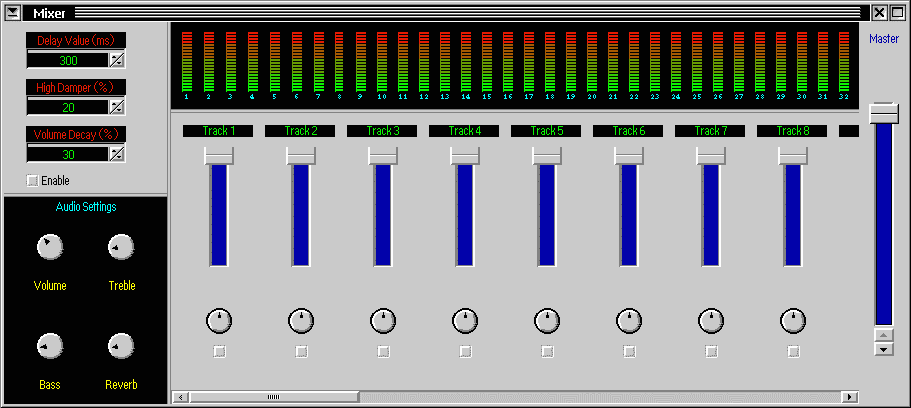
[Click here for a full sized version of this graphic]
Audio Tracks Window
MIDI Station Sequencer supports audio
recording -- you can record audio in real-time and, if your sound card supports
it, play it back with the rest of your mix using full duplex mode. The Audio Tracks
Window is sort of a cross between a mixing board and the main window -- audio tracks
come with their own mute, solo and volume controls, and the actual wave is displayed
on each track.
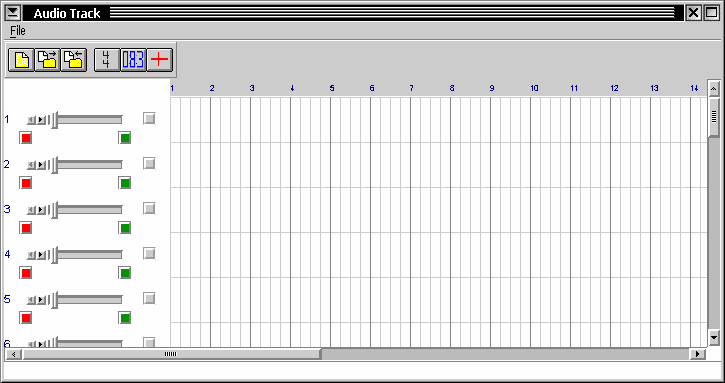
[Click here for a full sized version of this graphic]
Piano Roll
Piano Roll is a very useful feature
for people who need to make slight changes in a MIDI score but aren't proficient
in dealing with raw MIDI data. It lays out an entire MIDI track as if each note
were a separate "track" (key) on a piano.
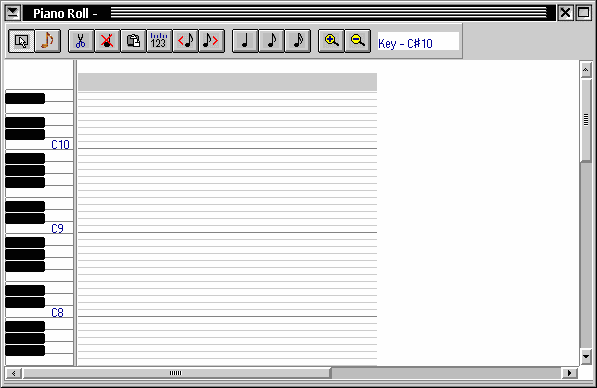
[Click here for a full sized version of this graphic]
Rhythm Editor
Anyone who has ever used a drum machine
is probably familiar with this interface -- rhythm instrument on the left-hand column,
measure markings at the top, and a grid in the middle where you place your beats.
This interface is a boon to people who actually have MIDI-capable drum machines,
because the interfaces that actually come with those instruments are generally very
cumbersome and annoying to use.
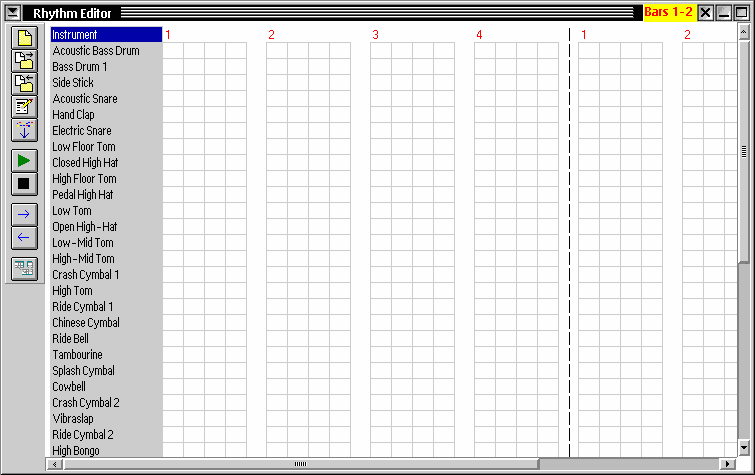
[Click here for a full sized version of this graphic]
Event List
For people familiar with the mathematics
behind MIDI sequencing, the Event List gives you absolute control over each MIDI
signal sent by the program. You can select and tweak each MIDI event on a case-by-case
basis.
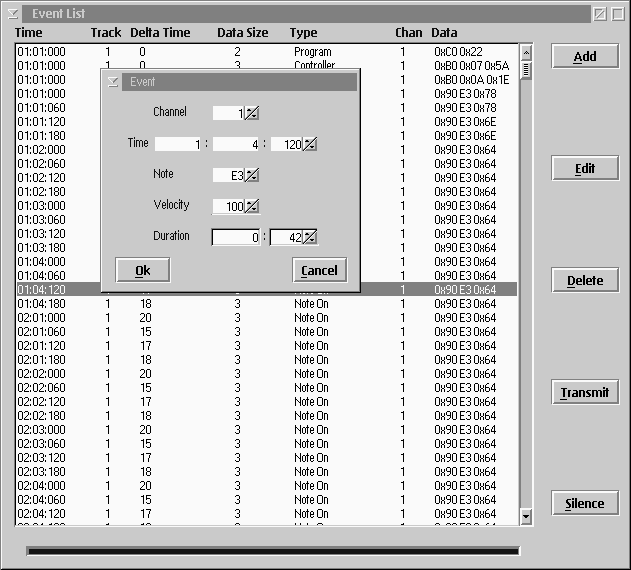
[ Click here for a full sized version of this graphic ]
Part Three: Using MIDI Station
Sequencer
Now
that you know all of the features and the MIDI Station Sequencer supports, the question
remains "how well does it work?" Depending on the reliability of your
hardware configuration and your level of expertise, the answer is "surprisingly
well."
MIDI Sequencing
MIDI Sequencing is by far MIDI Station Sequencer's strongest suit -- that was, after all, what the program was originally designed to do. MIDI Station Sequencer handles just about every type of MIDI Sequencing project you could imagine, and if you have a sound card that supports RTMIDI you get extremely accurate MIDI syncing.
MIDI
Station Sequencer is also very flexible when it comes to working with whatever MIDI
tone generators you happen to be using. For the most part, OS/2 tends to recognize
only MIDI devices that are separate from the sound card (Wavetable cards, external
tone generators, etc.) but it works with those quite well. Unfortunately, sometimes
the MIDI standard is not interpreted the same way by every manufacturer, and it
becomes necessary to modify how a sequencer sends and reads signals in order to
match the right sounds with the right signals. Fortunately, MIDI Station Sequencer
does this very well.
MIDI Station Sequencer comes with four pre-set MIDI configurations (shown in the graphic, below) that should cover most of the MIDI devices you'll run across. In the event it doesn't, you can modify those configurations or create a new one that matches your device.
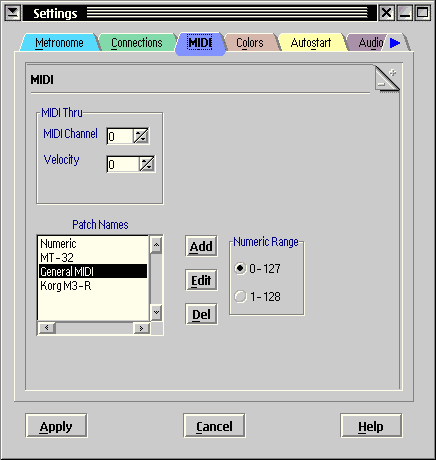
For example, MIDI devices generally
come with 128 pre-set patches (distinct sounds: piano, bass guitar, electric guitar,
violin, etc.). All MIDI devices assign a number to each patch, but some use the
range 0-127 and some use 1-128. Most devices seem to favor 0-127, with 0 being the
first patch and 127 being the the last, but occasionally you'll run into a device
that uses the range 1-128, and your MIDI patches will be thrown off by one. Suddenly
your grand piano will sound like a honky tonk piano, or your fretless bass will
sound like an electronic slap bass, and you'll have to go through each and every
patch and reset it.
MIDI
Station Sequencer avoids this by letting you define which range of numbers (0-127
or 1-128) you want to use beforehand. Then, when you're assigning patches to a track,
all you need to do is choose the instrument name instead of the number. If you choose
Grand Piano on a track, MIDI Station Sequencer will look at the Numeric Range you
chose. If the range you chose is 0-127 it will assign "0" to the instrument
"Grand Piano;" if it's 1-128, it will assign a "1." As long
as you stick with MIDI standard presets, it's possible to swap different kinds of
MIDI hardware and adapt to slightly different standards without laboriously going
through every track and changing the patch by one.
As
far as MIDI sequencing goes, MIDI Station Sequencer does just about everything you'd
expect from a program like Cakewalk or Cubase. Where MIDI Station Sequencer suffers
somewhat is in ease of use: while the Windows version of Cakewalk, for example,
allow a musician to do almost everything with a mouse, MIDI Station Sequencer often
requires you to punch numerical values into a keyboard before any information registers.
For
example, both Cakewalk and MIDI Station Sequencer have windows that allow you to
program rhythms as if you were working on a drum machine. In Cakewalk, coming up
with a basic rhythm is no more difficult than simply clicking your mouse on the
grid point that corresponds with the sound you want to use and the part of the measure
you want the sound to appear. In this way, it's possible to lay down a very basic
rhythm quickly, listen to it, and either discard it and try again or make whatever
adjustments you want to make afterwards. In MIDI Station Sequencer, however, when
you click on a grid point you must then enter in a numerical volume (0-127, with
0 being no noise and 127 being "full volume"), and then hit the enter
key on your keyboard for that setting to "stick." On the one hand this
makes it relatively easy to assign an intensity to a beat up front, on the other
hand it can really get in the way when you're trying to quickly experiment with
drum patterns before deciding on something basic and then modifying it to
your satisfaction.
Now,
I don't bring this up to criticize MIDI Station Sequencer -- it is a very young
program, all things considered, and Chris has provided an extensive array of features
without making usability horrid. In fact, it's not that the interface is confusing
or unusable, just that it seems very awkward compared to the older, more polished
Windows applications that do the same thing. Also, at present there really isn't
that much drag and drop integration in the application itself, which makes it feel
like something other than an OS/2 application.
Still,
the tradeoff for this is that you have access to just about every feature you get
in a Windows MIDI sequencer, without having to boot into Windows. There is a lot
of under-the-hood wizardry that needs to happen in order for these features to be
implemented, and it seems clear that at least to a certain extent, some of the shiny
happy UI optimizations were sacrificed in order to accomplish this.
From
the perspective of a novice to home recording, that would be the wrong choice. However,
I suspect that anyone who is looking for a MIDI Sequencing program for OS/2 is probably
fairly comfortable with sequencing in general to be able to figure out all the UI
quirks, and I find it far preferable to be able to call up all the tools I'm used
to, even if they're a little awkward to use. I'm not an expert by any stretch of
the imagination, but I know enough to want the tools first. The interface is capable
enough, it simply lacks the polish of some of the Windows applications. Polish can
usually be added after the fact, however.
Audio Recording
As of version 2.0, MIDI Station Sequencer
also supports digital audio recording. This is a significant addition to an already
impressive featureset. It is a capability that is showing up in a lot of Windows
sequencers, and it's very useful to musicians who have MIDI tracks that they're
trying to integrate with other instruments (guitar, bass, vocals, etc.)
MIDI Station Sequencer's digital
recording tools are not as well-rounded as its MIDI Sequencing tools, but they're
also a much newer addition to the program, and it's still possible to do quite a
bit with them. When you bring up the basic Audio Recording panel (shown below),
you can choose which sound card input to use, Line in or Microphone -- which input
you use depends on whether you want to use the Sound Card's internal "amplifier"
or you want to use an external, usually more powerful source to boost your signal.
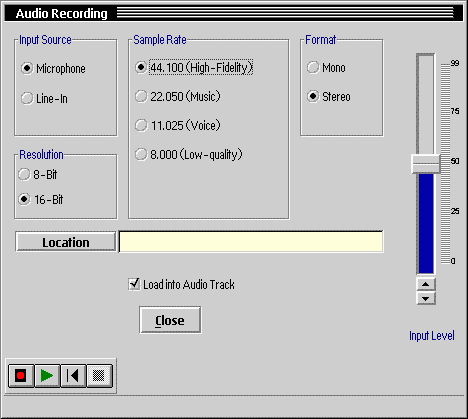
Audio recording in MIDI Station Sequencer
covers all the basics -- you can choose sample rates ranging from 8 - 44 kHz, record
in either mono or stereo, and choose between 8 and 16 bit sound quality. MIDI Station
Sequencer does not support 24 bit recording, but I don't know if OS/2 really supports
any 24 bit sound cards. This is more a limitation of OS/2's sound card drivers than
anything else. It does, however, make MIDI Station Sequencer less suitable for anyone
trying to set up a "serious" (as in, semi-professional) home recording
studio.
Another, more serious problem MIDI
Station Sequencer faces when recording audio is the lack of a visual aid to control
the Input Level. When recording analog audio in a digital format, it is very important
to make sure the sound coming in doesn't "peak" -- go past a certain level.
This level is usually represented visually, with three "ranges" of sound:
green, which is pretty safe though it will probably sound very quiet in your mix,
yellow, which is approaching the point of saturation, and red, which is where the
problems start. In analog studio recording (recording on a reel-to-reel mutlitrack)
it's common to try and aim for the loudest parts of the song to peak in the red
zones, because the distortion of the sound on an analog recording produces a pleasant
effect. In digital recording however, it just tends to mess everything up. MIDI
Station Sequencer doesn't provide any visual cues for this (at least, not that I've
found), so trying to find the right levels can be very challenging.
What it's Missing
While it's tempting to say that MIDI
Station Sequencer can do everything that Cakewalk or CuBase can do, that's unfortunately
not the case. There are things that products for other platforms can do that MIDI
Station Sequencer currently has no way of doing.
I've already mentioned the lack of
support for 24 bit sound cards -- again, I feel this has more to do with OS/2's
lack of 24-bit sound cards (I can't swear that there's no support, but there doesn't
seem to be any obvious support for them). 24 bit sound cards drastically
improve the quality of digital audio recordings, and most of the at least semi-serious
tools for other platforms have support or have add-on modules that support these
devices.
Further,
Macintosh and Windows applications usually have a huge array of plugins available
that can be used as special effects on individual tracks, or even the entire recording.
On the Windows platform, there are tons of DirectX plugins that simulate various
kinds of amp distortion, compression, reverb, flange, and chorus effects. While
many times these effects are overused or used in appropriately, there are times
when having access to these special features are incredibly useful. At this point
in time, MIDI Station Sequencer does not have support for plugins.
Version 3.0
While MIDI Station Sequencer version
2.2 is the latest full, stable release of the program, version 3.0 is being development
and some alpha versions are available for testing. This release promises to have
yet another incredibly useful feature -- support for samples and loops in the vein
of Sonic Foundry's Acid Music. With this feature it will be possible to import samples
and loops and arrange them in patterns along with your MIDI Sequences and Audio
Tracks. I use Acid Music when I'm in Windows, and am looking forward to using a
similar setup under OS/2.
Final Thoughts
MIDI Station Sequencer is an excellent
program that is still being actively developed. Because of this, many of the tools
are still a bit rough around the edges and can be awkward to use. However, the fact
that the tools are really there, and can really be used, is extremely impressive.
There are caveats, however. If you're
new to the world of MIDI Sequencing and Home Studio Recording, you may find MIDI
Station Sequencer a bit rough to try and learn it on. The digital audio recording
tools still need more work, and if you're looking for high-end soundcard support,
MIDI Station Sequencer isn't well suited to your needs. The biggest problem of all,
however, has very little to do with MIDI Station Sequencer itself -- RTMIDI support
in OS/2 sound card drivers is wildly inconsistent, and if you can't get your card
to work with RTMIDI then most of MIDI Station Sequencer's features will be out of
your reach.
However, if you can get RTMIDI to
work, MIDI Station Sequencer can be an excellent supplement to your Home Studio,
even if it probably won't replace your Windows setup. As MIDI Station evolves, it
will become both easier and more powerful to use. As it stands right now, it's still
an excellent tool, and if you're looking for a sequencing program for OS/2, and
if you can get RTMIDI working on your sound card, I heartily recommend it.
MIDI
Station Sequencer, Shareware, $30 at BMT Micro
Author: Christopher Hodges
Application Home Page: http://www.dinosoft.it/~midistation/mstatseq.html
|
Home |
Next Article |
|||